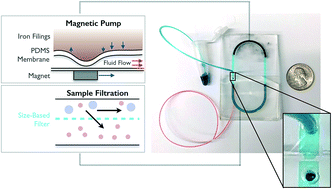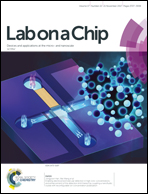Microfluidic diafiltration-on-chip using an integrated magnetic peristaltic micropump†
Abstract
Diafiltration is a membrane filtration technique that rapidly removes permeable molecules from a solution by controlling the tangential and orthogonal flows over a membrane and by replenishing the permeate with an equivalent amount of replacement buffer. However, its application to the purification of many key biomaterials and nanomaterials has been limited by the large dead volume (>10 mL) that is required to automate the process. To address this challenge, we have developed a diafiltration-on-a-chip device that can process low-volume samples (50 μL). The key innovation of this device is a magnetically-driven on-chip peristaltic pump that is able to continuously drive fluid flow at rates as high as 50 mL h−1 with minimal external instrumentation and a dead volume of <50 μL. To demonstrate the utility of this device, we purified microbeads from dye with >99% purity and >96% retention within two hours. We additionally showed that cells could be purified from microbeads with >97% purity and >97% retention in two hours. Because our approach requires minimal instrumentation, it is well suited for on-chip parallelization, which was demonstrated by incorporating four complete diafiltration systems onto a single credit card-sized chip.



 Please wait while we load your content...
Please wait while we load your content...